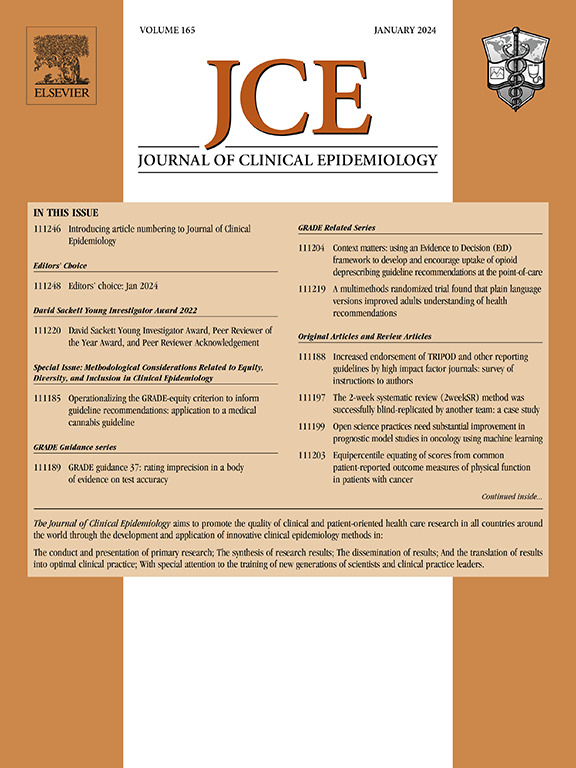利用真实世界数据模拟现有的前列腺癌治疗试验:挑战与经验教训。
IF 7.3
2区 医学
Q1 HEALTH CARE SCIENCES & SERVICES
引用次数: 0
摘要
目的:如果随机对照试验可以成功地使用真实世界数据(RWD)进行模拟,那么对于RWD在评估试验中未评估的问题的治疗效果方面的有效性的信心就会增加。我们使用来自英国的常规收集的行政和临床国家相关数据集来模拟高风险前列腺癌患者的PR07试验,该试验比较了随机化后8周内(“宽限期”)放疗加激素治疗(RT+HT)和仅激素治疗(HT)对全因死亡率的影响。我们强调了在模拟这一试验中所需要的方法选择和遇到的挑战。研究设计和背景:2014年至2020年诊断为前列腺癌的患者从常规国家关联数据集中确定。以诊断为时间零点。由于很少有患者在诊断后8周内开始放疗,我们考虑了4-6个月的宽限期靶向试验。我们感兴趣的估计是风险比(hr)和7年以上的生存概率。克隆-审查-加权(CCW)方法用于控制测量的混淆和允许宽限期。我们还使用了扩展(“里程碑- ccw”方法),其中我们考虑了诊断后的几个时间起源,使我们能够像PR07一样使用8周的宽限期。结果:共有2690例患者符合纳入模拟试验的条件。CCW分析使用6个月的宽限期,估计HR为0.48 (95%CI: 0.34-0.60), RT+HT策略的7年生存率估计为80.7% (95%CI: 74.3-87.0),单纯HT策略的7年生存率估计为65.6% (95%CI: 62.8, 68.1),相应的风险差异为15.1% (95%CI: 11.5-18.9)。landmark-CCW方法的相应HR为0.58 (95%CI: 0.51-0.65), RT+HT策略的生存估计为80.7% (95%CI: 77.7-83.8),单纯HT策略的生存估计为69.8% (95%CI: 68.2-71.4),风险差异为10.9% (95%CI: 6.3-15.9)。结论:我们使用RWD的模拟试验的结果与PR07的结果大致一致,与仅使用HT相比,RT+HT估计可获得更好的生存率。然而,研究结果并没有完全重复,在7年的随访中,PR07报告的风险比为0.77 (95%CI: 0.61-0.98)。差异的部分原因可能是在定义零时间和允许与PR07相同的治疗宽限期方面存在挑战。我们的研究考虑了解决这些挑战的方法,我们的研究结果证实了RWD在估计治疗效果方面的实用性。本文章由计算机程序翻译,如有差异,请以英文原文为准。

Emulating an existing trial of treatments for prostate cancer using real-world data: challenges and lessons learned
Objectives
If randomized controlled trials can be successfully emulated using real-world data (RWD), confidence in the validity of RWD for estimating treatment effects for questions that have not been assessed in trials increases. We used routinely collected administrative and clinical national linked datasets from England to emulate the PR07 trial for high-risk prostate cancer patients, which compared the effects of radiotherapy added to hormone therapy (RT+HT) within 8 weeks of randomization (the “grace period”) and hormone therapy (HT) only on all-cause mortality. We highlight methodological choices required and challenges encountered in emulating this trial.
Study Design and Setting
Patients diagnosed with prostate cancer from 2014 to 2020 were identified from the routine national linked datasets. Diagnosis was taken as the time zero. As few patients initiated radiotherapy within 8 weeks of diagnosis, we considered target trials with grace periods of 4-6 months. Estimands of interest were hazard ratios (HRs) and survival probabilities over 7 years. The cloning-censoring-and-weighting (CCW) approach was used to control for measured confounding and to allow for the grace period. We also used an extension (the “landmark-CCW” approach), in which we consider several time-origins post-diagnosis, enabling us to use a grace period of 8 weeks as in PR07.
Results
A total of 2,690 patients were eligible for inclusion in the emulated trial. The CCW analysis using a grace period of 6 months gave an estimated HR of 0.48 (95% confidence interval [CI]: 0.34–0.60) and 7-year survival estimates of 80.7% (95% CI: 74.3–87.0) for the RT+HT strategy and 65.6% (95% CI: 62.8–68.1) for HT only strategy, and corresponding risk difference of 15.1% (95% CI: 11.5–18.9). The corresponding HR from the landmark-CCW approach was 0.58 (95% CI: 0.51–0.65) and with survival estimates of 80.7% (95% CI: 77.7–83.8) for RT+HT strategy and 69.8% (95% CI: 68.2–71.4) for the HT only strategy, and a risk difference of 10.9% (95% CI: 6.3–15.9).
Conclusion
Our findings from the emulated trial using RWD are broadly consistent with those from PR07, with RT+HT estimated to result in better survival compared to HT only. However, the findings were not replicated exactly, with PR07 reporting an HR of 0.77 (95% CI: 0.61–0.98) over 7 years of follow-up. Differences may be in part due to challenges in defining time zero and allowing for a treatment grace period of the same duration as in PR07. Our study considered ways in which these challenges can be addressed, and our findings affirm the utility of RWD for estimating treatment effects.
Plain Language Summary
Clinical trials are the best way to test whether treatments work, but they are expensive, take years to complete, and focus on narrow research questions. If we can use real-world data (RWD) such as patient health records to mimic these trials, we may be able to answer additional medical questions relevant to patients who are prescribed these medications. This study aimed to see if we could recreate the results of a past clinical trial (PR07) using national health data from England. The PR07 trial looked at two treatments for high-risk prostate cancer: hormone therapy (HT) alone and radiotherapy added to hormone therapy (RT+HT) within 8 weeks of starting the study. This trial was chosen for several reasons. It included high-risk patients who were studied for up to 7 years, meaning that there was enough information to study survival outcomes. Being a major UK-based trial, it was useful for comparing with the data recorded in UK national health data. The trial also allowed some flexibility in when treatment started, which was an interesting factor to examine. Its main goal was to see if adding radiotherapy to hormone therapy provided extra benefits to patients. We wanted to see whether the trial results were replicated using the UK health data. If results were replicated, it would provide confidence in further exploration of questions not covered by the trial. In a trial, randomization time is the point where doctors allocate patients to one of the treatments being assessed, usually 1 new treatment and 1 control treatment. Patients in the study are then followed up from that point. However, defining a starting point in a non-trial setting, using UK national health data, is not as straightforward. In the PR07 trial, patients started RT+HT within 8 weeks of randomization. In the UK datasets, we use diagnosis as a starting point, because it is available for both treatment groups. However, very few patients started RT+HT within 8 weeks of diagnosis. To address this, we allowed for longer periods of 4–6 months from diagnosis for RT+HT initiation. Recent developments provided statistical methods for estimating the cause-effect relationship between treatment received and survival patterns. In this study, we show how these approaches can be used to estimate survival patterns if all patients had RT+HT within 4–6 months from diagnosis compared with if no patients had any RT within 4–6 months. We account for the different treatment initiation times and the main differences between the RT+HT and HT only patients. Using these methods, we estimate that RT+HT has an 11%–15% higher survival rate at 7 years compared to HT only. We discuss similarities and differences between these findings and those in the original PR07 trial.
求助全文
通过发布文献求助,成功后即可免费获取论文全文。
去求助
来源期刊

Journal of Clinical Epidemiology
医学-公共卫生、环境卫生与职业卫生
CiteScore
12.00
自引率
6.90%
发文量
320
审稿时长
44 days
期刊介绍:
The Journal of Clinical Epidemiology strives to enhance the quality of clinical and patient-oriented healthcare research by advancing and applying innovative methods in conducting, presenting, synthesizing, disseminating, and translating research results into optimal clinical practice. Special emphasis is placed on training new generations of scientists and clinical practice leaders.
 求助内容:
求助内容: 应助结果提醒方式:
应助结果提醒方式:


